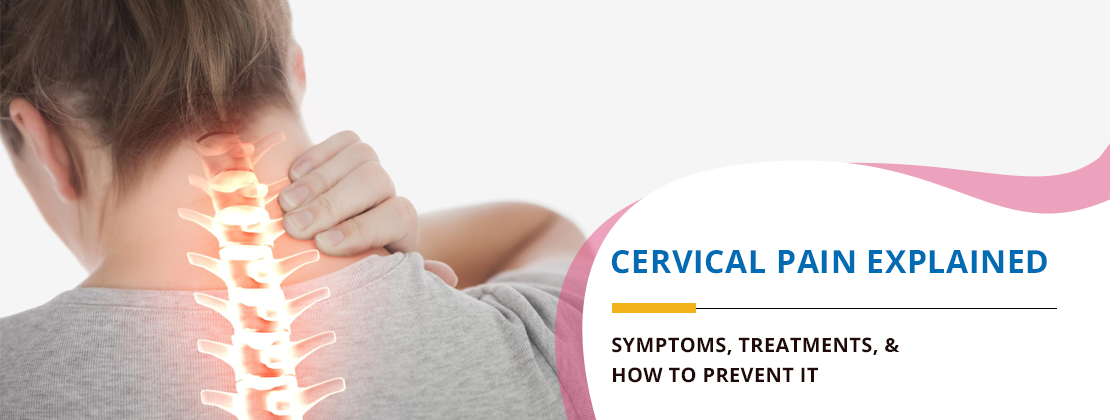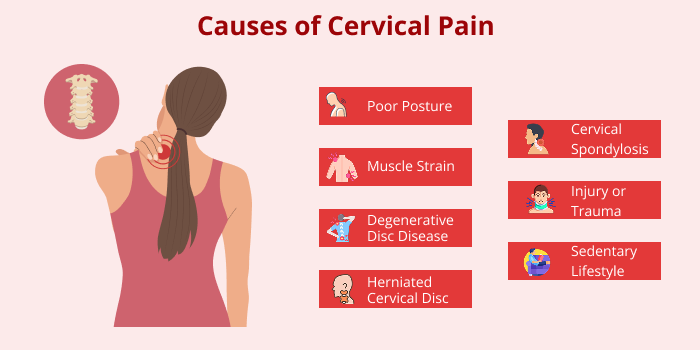
Home / Blog / Cervical Pain Explained: Symptoms, Treatments, & How to Prevent It
April 9, 2025

Cervical pain refers to the discomfort or pain related to the cervical spine, consisting of the neck’s first seven vertebrae. This type of neck pain can be anything from mild discomfort to debilitating chronic neck pain, interfering with daily activities.
Usually, cervical pain stems from strains of cervical muscles, degenerative conditions, or injury, and it may extend to the shoulders, arms, or head. In certain cases, the pain may affect concentration and productivity; thus, early intervention is paramount.
Recognising cervical pain symptoms early can help prevent complications and chronic issues. Common signs include:
These cervical pain symptoms may develop gradually or suddenly, depending on the underlying cause. Ignoring them may result in worsening conditions or long-term complications.

Cervical pain causes can vary from lifestyle habits to underlying medical conditions. Some of the most common include:
Understanding the different cervical pain causes helps tailor effective treatment plans and preventive strategies.
Proper diagnosis is essential to determine the right cervical pain treatment. Your healthcare provider may:
In some cases, blood tests may also be recommended to identify the underlying cause of cervical pain.
The goal of cervical pain treatment is to relieve symptoms, restore function, and prevent recurrence. Common non-surgical neck pain treatments include:
Neck pain relief often involves a combination of these approaches. Consistency in therapy and adherence to medical advice are key to achieving long-term cervical pain relief.
When conservative treatments are not effective, advanced therapies may be considered:
Discussing these advanced options with a spine specialist ensures a comprehensive and personalised treatment approach.
Preventing cervical pain involves adopting health-conscious behaviours and maintaining spinal integrity. Here are several practical tips:
Early prevention reduces the likelihood of developing chronic neck pain or requiring advanced cervical pain treatment.

Maintaining long-term neck health involves daily commitment and awareness:
Incorporating these lifestyle habits can significantly improve neck pain relief and promote lasting spinal wellness.
By understanding cervical pain, recognising signs and symptoms, and knowing the various treatment and preventive measures available, including some advanced treatment methods such as PRP treatment for cervical pain, you can take charge of your neck pain relief journey and maintain long-term neck and spine health.
For those suffering from cervical pain, early intervention is essential. Consult a healthcare professional to explore personalised cervical pain treatment plans tailored to your condition.
At HCG Hospitals, a super-speciality hospital in India, we offer holistic care for cervical pain, with a special focus on the quality of life of our patients.
Yes, especially if it results in chronic neck pain or is linked to structural issues like a herniated cervical disc. Prompt evaluation and proper cervical pain treatment are crucial.
Cervical pain is a specific form of neck pain that involves the cervical spine and surrounding cervical muscles. While all cervical pain is neck pain, not all neck pain originates from cervical spine problems.
Look for common cervical pain symptoms such as neck stiffness, radiating pain to arms or shoulders, and tingling or weakness. Medical imaging and physical exams confirm the diagnosis.
You should seek medical help if your neck pain persists beyond a week, follows an injury, or includes symptoms like numbness, weakness, or difficulty moving.